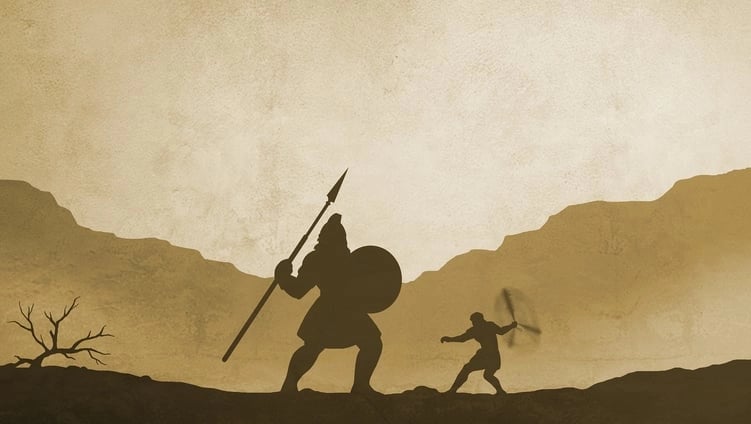Why the Right Pricing Strategy is Important
Good strategy is like great art. It’s difficult to define it, but you immediately recognize it when you see it.
Here is a classic example:
In the tale of David and Goliath, David was confident in his slingshot abilities and likely well aware of Goliath’s weakness. Therefore, risking the challenge and rejecting protection that would have slowed him was a good life-saving strategy.

Unfortunately, a good strategy is rare. More often than not, the adjective “strategic” hardly has any significant meaning when added to a business function such as strategic marketing, strategic finance — or strategic pricing.
Yet, well-established rituals such as pricing strategy are defined simply as “We aim for profitable growth.”
Surprisingly, this vague definition is flexible enough to justify any pricing goal, including both profit and revenue maximization—depending on who you talk to. Upper management and marketing typically prefer profit, while sales favor revenue.
Unfortunately, bad pricing strategies are so common that most pricing professionals have never experienced the power of a good pricing strategy.
So, let’s see if we can change that by discussing what constitutes a pricing strategy, outlining a concept for developing a good strategy, and looking at some product and pricing strategy examples.
The Pricing Strategy Framework
In general, strategy is all about the choice. This is especially true with pricing strategy, in which you decide to do one thing, not the other.
If a company decides it is fully committed to profit, it risks losing customers. If it aims for revenue, it can keep more customers but may upset stockholders—resulting in slim bonuses.
Such fundamental trade-offs are inevitable on the road to choosing the right pricing strategy. They need to be addressed, discussed, and decided.
The key objective of pricing is to support the company's overall strategy.
The pricing strategy is the pricing manager’s theory of how to best achieve this. If the company’s objective is immediate profit maximization, then an effective pricing strategy would be focused on leveraging the company's maximum value.
One of this decade's most useful practical books on strategy is undoubtedly Richard Rumelt’s (2001) “Good Strategy, Bad Strategy.” In addition to his many entertaining examples, Rumelt’s book describes a three-step framework for developing a good strategy: 1) diagnosis, 2) guiding policy, and 3) coherent action.

- Does it make sense to only follow the pricing of key competitors with an established product?
- Should you price an innovation low to keep competitors out of the market or high to profit off the inflated willingness-to-pay of early adopters?
3. Coherent action: This includes the coordinated implementation of the guiding policy in the pricing methods, tools, and processes. The complexity of this task depends on the industry’s pricing requirements (e.g., number of products, differentiation between customers) and the company's role (e.g., price leader or follower).
Pricing Strategy Examples
Let’s revisit the Tale of David and Goliath, examine it in accordance with ‘The Pricing Strategy Framework,’ and describe the diagnosis, guiding policy, and coherent action through David's point of view.
- Diagnosis: Goliath is the strongest man in the world and is considered undefeatable (Threat). I'm weak (Weakness) but pretty good with the slingshot, which is a secret (Strength). Also, I’ve detected a spot in Goliath’s armor, where he is unprotected — right between his eyes (Opportunity). A clever case of classical SWOT analysis!
-
Guiding policy: I can beat him if I hit him with my slingshot before he comes too close. Therefore, I need to be agile to get one good shot at him. That is my only chance.
-
Coherent action: I reject the armor that was offered to me. It would only make me slower and doesn’t offer protection if Goliath hits me. I focus all attention on my first — and probably only — shot.
There are two takeaways from this example that are common for good strategy: First, a good strategy is very clear and straightforward. Second, don’t expect others to comprehend or appreciate it before they have seen its success.
Now, let’s highlight two historicalexamples of product and pricing strategy.
The Company That Got America On the Internet
AOL was the internet giant of the 1990s. It's the name that introduced dial-up internet to the people and later merged as the larger partner with Time Warner in 2001. However, with the advent of broadband internet, it became clear that AOL’s dial-up business was dying down.
-
Diagnosis: With its 56 kilobits per second, AOL had a much inferior technology compared to broadband’s 16+ megabits per second. But, with a multi-million user base and slow churn in many segments, there was still hope.
-
Guiding policy: Pricing on value and substantially reducing prices to compete directly did not benefit the industry. Therefore, the focus needed to be on reducing churn.
-
Coherent action: AOL maintained prices at $20 per month and fought to win back each lost customer by offering free months or reduced rates.
-
Result: AOL still had over 2 million paying customers and was sold to Verizon Communications for $4.4 billion in 2015.
From Farm Boy to Business Visionary
Oil lamps are a classic example of a good pricing strategy. When oil producers gave away lamps for free, people soon needed to buy oil to fuel their lamps.
-
Diagnosis: When oil became readily available, there wasn’t enough demand for it. Lamps were unaffordable for most people, even if they had the advantage of having access to light all day and night.
-
Guiding policy: They removed the initial high barrier of buying an expensive lamp and made it easy for people to get accustomed to consuming oil. The recurring payments for oil were small steps for the customers but a major profit for the seller.
-
Coherent action: They gave away the lamps for free and then sold the oil.
-
Result: The oil baron John D. Rockefeller became the first billionaire and controlled about 90% of the oil industry by the 1890s.
This model has been widely adopted by manufacturers of various products ranging from razor blades to coffee tabs. These days, electric vehicle manufacturers are attempting a variation of this model, but they still have a long way to go.
In the traditional automotive business model, many manufacturers sold their vehicles with nearly zero margins and earned their living by selling spare parts and services at a better margin.
Today, electric vehicles are sold at a lower cost but don't need many service parts, such as oil filters. Eventually, autonomous driving will also take away a large share of accident-related parts. For now, it's unclear how to make money with e-mobility.
The industry clearly lacks a good pricing strategy.
Buynomics: Your Modern Pricing Strategy Solution
Technology and AI simplify pricing for corporations. Buynomics is a unique tool that turns your raw data into actionable insights you can use to price your products and beat the competition.
Having a well-developed pricing strategy matters, and Buynomics helps you calculate what metrics are important to your business. We use our Virtual Shopper AI to replicate the purchasing habits of real customers, which can be used to simulate the effects of pricing, portfolio changes, and promotions on sales, revenue, or profits.
Book a demo with one of our experts today to see our solution in action!

September 11, 2023
.png?width=520&height=294&name=Commodity%20Price%20Index%20Evolution%20(Jan%202015%20=%20100).png)
